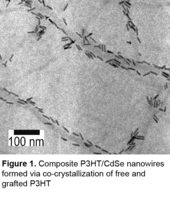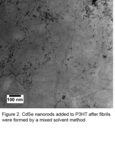Highlight
Nano-Scale Segregation for More Efficient Polymer Photovoltaics
Achievement/Results
Polymer-based photovoltaic materials offer the promise of portable, affordable, flexible, and sustainable alternatives to fossil fuels. Well-controlled nano-scale segregation of p- and n- type materials to form effective p-n junctions is essential for viable and efficient photovoltaic devices. Our efforts in Prof. Ryan Hayward’s group to achieve such control have focused on co-organization of the p-type conjugated polymer poly(3-hexyl thiophene) (P3HT) with n-type cadmium selenide (CdSe) nanorods. Poly(alkylthiophenes) (PATs) are extensively used as p-type components of organic solar cells, and tend to form crystalline structures in the form of nano-scale fibers, whiskers, and wires. Inorganic semiconductor nanoparticles such as CdSe have also been proven as viable materials for the electron-conducting components of hybrid inorganic/organic photovoltaic devices.
We have shown that these electron-conducting and hole-conducting materials can be paired through solution-state self-assembly into composite nanowires, as shown in Figure 1. These composite materials provide pre-organized building blocks for photovoltaic devices with well-defined structures on the diffusion length-scale of an electron-hole pair, providing opportunities to minimize recombination and maximize charge transport. When conditions are not properly controlled for co-organization the resulting material (Figure 2) is a segregated mixture of bare P3HT wires and aggregated nanorods which is not optimal for a photovoltaic cell due to the large sizes of the aggregated n-type domains and the minimal interface between P3HT nanowires and CdSe nanorods. Currently, we are working to generalize this approach to other polymer architectures and semiconducting materials. This research is an ongoing collaboration with Todd Emrick’s research group in the Polymer Science and Engineering department.
Address Goals
This activity addresses the primary NSF strategic goal by identifying the fundamental chemistry and materials proerties necessary to improve the efficiency of polymeric photovoltaic devices.
The activity addresses the secondary goal through the research training of the IGERT student (Felicia Bokel) and through her participation in the Northeast Alliance for Graduate Education and the Professoriate (NEAGEP) recruiting weekend for minority students interested in pursuing graduate school. She presented a research poster and networked with students to answer questions and concerns about applying to, attending graduate school and performing PhD level research.







